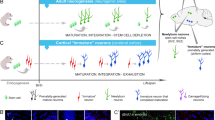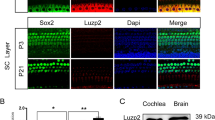Abstract
The development of the inner ear is an orchestrated process of morphogenesis with spatiotemporally controlled generations of individual cell types. Recent studies have revealed that the Sox gene family, a family of evolutionarily conserved HMG-type transcriptional factors, is differentially expressed in each cell type of the mammalian inner ear and plays critical roles in cell-fate determination during development. In this study, we examined the expression pattern of Sox21 in the developing and adult murine cochlea. Sox21 was expressed throughout the sensory epithelium in the early otocyst stage but became restricted to supporting cells during adulthood. Interestingly, the expression in adults was restricted to the inner phalangeal, inner border, and Deiters’ cells: all of these cells are in direct contact with hair cells. Evaluations of the auditory brainstem-response revealed that Sox21−/− mice suffered mild hearing impairments, with an increase in hair cells that miss their appropriate planar cell polarity. Taken together with the previously reported critical roles of SoxB1 families in the morphogenesis of inner ear sensory and neuronal cells, our results suggest that Sox21, a counteracting partner of the SoxB1 family, controls fine-tuned cell fate decisions. Also, the characteristic expression pattern may be useful for labelling a particular subset of supporting cells.





Similar content being viewed by others
References
Dabdoub A, Puligilla C, Jones JM et al (2008) Sox2 signaling in prosensory domain specification and subsequent hair cell differentiation in the developing cochlea. Proc Natl Acad Sci USA 105:18396–18401
Puligilla C, Dabdoub A, Brenowitz SD et al (2010) Sox2 induces neuronal formation in the developing mammalian cochlea. J Neurosci 30:714–722
Uchikawa M, Kamachi Y, Kondoh H (1999) Two distinct subgroups of Group B Sox genes for transcriptional activators and repressors: their expression during embryonic organogenesis of the chicken. Mech Dev 84:103–120
Bowles J, Schepers G, Koopman P (2000) Phylogeny of the SOX family of developmental transcription factors based on sequence and structural indicators. Dev Biol 227:239–255
Bani-Yaghoub M, Tremblay RG, Lei JX et al (2006) Role of Sox2 in the development of the mouse neocortex. Dev Biol 295:52–66
Bylund M, Andersson E, Novitch BG et al (2003) Vertebrate neurogenesis is counteracted by Sox1-3 activity. Nat Neurosci 6:1162–1168
Favaro R, Valotta M, Ferri AL et al (2009) Hippocampal development and neural stem cell maintenance require Sox2-dependent regulation of Shh. Nat Neurosci 12:1248–1256
Ferri AL, Cavallaro M, Braida D et al (2004) Sox2 deficiency causes neurodegeneration and impaired neurogenesis in the adult mouse brain. Development 131:3805–3819
Kan L, Israsena N, Zhang Z et al (2004) Sox1 acts through multiple independent pathways to promote neurogenesis. Dev Biol 269:580–594
Wang TW, Stromberg GP, Whitney JT et al (2006) Sox3 expression identifies neural progenitors in persistent neonatal and adult mouse forebrain germinative zones. J Comp Neurol 497:88–100
Sandberg M, Kallstrom M, Muhr J (2005) Sox21 promotes the progression of vertebrate neurogenesis. Nat Neurosci 8:995–1001
Kiso M, Tanaka S, Saba R et al (2009) The disruption of Sox21-mediated hair shaft cuticle differentiation causes cyclic alopecia in mice. Proc Natl Acad Sci USA 106:9292–9297
Masuda M, Nagashima R, Kanzaki S et al (2006) Nuclear factor-kappa B nuclear translocation in the cochlea of mice following acoustic overstimulation. Brain Res 1068:237–247
Mizutari K, Fujioka M, Nakagawa S et al (2010) Balance dysfunction resulting from acute inner ear energy failure is caused primarily by vestibular hair cell damage. J Neurosci Res 88:1262–1272
Fujioka M, Kanzaki S, Okano HJ et al (2006) Proinflammatory cytokines expression in noise-induced damaged cochlea. J Neurosci Res 83:575–583
Lawoko-Kerali G, Rivolta MN, Lawlor P et al (2004) GATA3 and NeuroD distinguish auditory and vestibular neurons during development of the mammalian inner ear. Mech Dev 121:287–299
Kiernan AE, Pelling AL, Leung KK et al (2005) Sox2 is required for sensory organ development in the mammalian inner ear. Nature 434:1031–1035
Hume CR, Bratt DL, Oesterle EC (2007) Expression of LHX3 and SOX2 during mouse inner ear development. Gene Expr Patterns 7:798–807
Mak AC, Szeto IY, Fritzsch B et al (2009) Differential and overlapping expression pattern of SOX2 and SOX9 in inner ear development. Gene Expr Patterns 9:444–453
Ohba H, Chiyoda T, Endo E et al (2004) Sox21 is a repressor of neuronal differentiation and is antagonized by YB-1. Neurosci Lett 358:157–160
Zine A, Aubert A, Qiu J et al (2001) Hes1 and Hes5 activities are required for the normal development of the hair cells in the mammalian inner ear. J Neurosci 21:4712–4720
Sage C, Huang M, Vollrath MA et al (2006) Essential role of retinoblastoma protein in mammalian hair cell development and hearing. Proc Natl Acad Sci USA 103:7345–7350
Rio C, Dikkes P, Liberman MC et al (2002) Glial fibrillary acidic protein expression and promoter activity in the inner ear of developing and adult mice. J Comp Neurol 442:156–162
Coppens AG, Kiss R, Heizmann CW et al (2001) Immunolocalization of the calcium binding S100A1, S100A5 and S100A6 proteins in the dog cochlea during postnatal development. Brain Res Dev Brain Res 126:191–199
Bermingham-McDonogh O, Oesterle EC, Stone JS et al (2006) Expression of Prox1 during mouse cochlear development. J Comp Neurol 496:172–186
Bianchi LM, Liu H, Krug EL et al (1999) Selective and transient expression of a native chondroitin sulfate epitope in Deiters’ cells, pillar cells, and the developing tectorial membrane. Anat Rec 256:64–71
Sato T, Doi K, Taniguchi M et al (2006) Progressive hearing loss in mice carrying a mutation in the p75 gene. Brain Res 1091:224–234
Murata J, Tokunaga A, Okano H et al (2006) Mapping of notch activation during cochlear development in mice: implications for determination of prosensory domain and cell fate diversification. J Comp Neurol 497:502–518
Jin ZH, Kikuchi T, Tanaka K et al (2003) Expression of glutamate transporter GLAST in the developing mouse cochlea. Tohoku J Exp Med 200:137–144
Acknowledgments
We thank Ms. Ayano Mitsui and Dr. T. Nagai for their technical assistance and Dr. Junko Murata (Osaka University) for technical advices. This work was supported by grants from the Ministry of Education, Culture, Sports, Science and Technology (MEXT), the Japan Science and Technology Corporation (JST), and the Funding Program for World-leading Innovative R&D on Science and Technology to H.O., and by a Grant-in-Aid for Scientific Research B (20390444) to K.O., and by a Research on Measures for Intractable Diseases from the Ministry of Health, Labor and Welfare of Japan to M.F., and by a Keio University grant-in-aid for encouragement of young medical scientists to M.F., and by a Keio Gijuku Academic Development Funds to M.F. and by a Grant-in-Aid for Young Scientists B (22791628) to M.F. from MEXT. and by a grant-in-aid from the Global COE Program of MEXT, Japan to Keio University.
Author information
Authors and Affiliations
Corresponding author
Additional information
Special Issue: In Honor of Dr. Mikoshiba.
Electronic supplementary material
Below is the link to the electronic supplementary material.
11064_2011_416_MOESM1_ESM.tif
Double labeling of EGFP and Sox21 protein. All of the nuclei of EGFP-positive cells were labeled with anti-Sox21 antibody (red), indicating that the EGFP-expression in Sox21/EGFP mouse reflects endogenous protein expression of Sox21. (Scale Bar: 50 μm in A) (TIFF 1025 kb)
11064_2011_416_MOESM2_ESM.tif
ABR threshold of all mice tested. Hearing function of both wild type and knock out was tested (N = 3 and 4, respectably). At both frequencies, threshold was elevated in knock out in comparison to wildtype (TIFF 139 kb)
Rights and permissions
About this article
Cite this article
Hosoya, M., Fujioka, M., Matsuda, S. et al. Expression and Function of Sox21 During Mouse Cochlea Development. Neurochem Res 36, 1261–1269 (2011). https://doi.org/10.1007/s11064-011-0416-3
Accepted:
Published:
Issue Date:
DOI: https://doi.org/10.1007/s11064-011-0416-3




